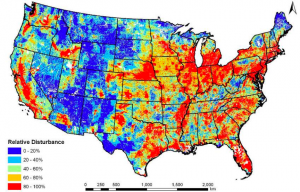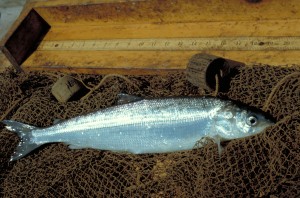
Red areas have habitats potentially most vulnerable to a changing climate. Click to enlarge. Image: Dana Infante, Peter Esselman, Li Wang
Facing an inhospitable habitat, fish either have to move or die, says Bryan Pijanowski, a Purdue University associate professor of forestry and natural resources.
“Some of the fish live in aquatic systems that are completely compartmentalized – they’re dammed off,” he says. “So they can’t move.”
Models show how global climate change also changes how land is used on global or national scales. But now Pijanowski and other researchers are combining these broad models with new research to predict the effects on fish in local streams, including identifying the manmade barriers to migration.
The scientists hope to predict, for instance, how the cold-water-loving cisco will adapt to a warmer Great Lakes. They want to know how warming waters will prompt largemouth bass to move further north. They hope to discover if brook trout may have to abandon mid-Michigan rivers for colder water. The findings will help resource managers decide how best to protect key species and habitats.
The project, funded by the United States Geological Survey’s National Climate Change and Wildlife Science Center, includes researchers from that agency, Michigan State University, Penn State University, the University of Minnesota-Duluth, the Minnesota Department of Natural Resources and Michigan Department of Natural Resources.
The scientists will link climate change models and predicted land-use changes to understand how fish habitat and distributions will change over 30, 50 and 100 years.

Researchers hope to predict how fish like Great Lakes cisco adapt to a changing climate. Photo: EPA
Existing models predict large-scale effects, like increased drought or flooding, says Craig Paukert, assistant professor of fisheries at Kansas State University and the project’s lead investigator.
“If you’re an individual state manager like a state fish and wildlife agency, that doesn’t help you a whole lot,” he says. “We’re trying to take those models and downscale them to make it more relevant for policy and decision makers at the state and regional level.”
The goal is to help resource managers protect vulnerable watersheds and important species.
“The quality of the water depends on how we manage the land,” Pijanowski, who studies how land-use changes affect water and fish. “If we don’t do it right, we’re just going to destroy those precious resources.”
Pijanowski says high corn prices driven by demand for biofuels led to a significant amount of Indiana woodlands being used to produce corn.
“What I’m seeing here is a pretty transformational landscape, back into more intensive uses of the land” for food and biodiesel production, he says. Those changes, along with increased urban sprawl and changing irrigation practices, can contribute increased nutrients and sediments into the water.
“If we destroy a lot of these natural resources that people want to go to and recreate, we’re also destroying our local economies,” Pijanowski says. “In some cases we have small communities in these rural areas that depend on fishermen to come there for trout fishing in the spring and in the fall.”
By the fall of 2011, the team hopes to determine the areas most vulnerable to habitat change. It plans to predict fish distribution changes by 2013.
Pijanowski says the team feels a sense of urgency to complete the project.
“We have to get it done now quickly because we have to have plans in place,” he says. “The longer we wait, probably, the costs go up.”
The project’s findings won’t just benefit resource managers. Pijanowski says fishing on his grandparents’ lake as a child helped him choose a career in ecology.
“A lot of people have those childhood experiences,” he says. “We want our kids to have those. We want our grandkids to have them.
“They make up who we are.”
“Pijanowski says high corn prices driven by demand for biofuels led to a significant amount of Indiana woodlands being used to produce corn.”
How ironic that we would destroy significant woodland habitat to restock our missmanaged food stores. Might drilling in Anwar might yield much more power with a much smaller forest footprint (2 acres per site)?
These fish probably migrated some during the global cooling of the 1970s, the global warming of the 1990s and again during the cooling trend of the last 8 years. They migrated as the glaciers shaped this land and they’ll adapt just fine if/when they move another 100-200 miles. These fishing towns are probably more worried about truely man-made problems such as asian carp.
Here’s a simple way to help draw attention to the fact that climate change is still happening and people around the world want to find a solution. On March 27, 2010, World Wildlife Fund is asking individuals, businesses, governments and organizations around the world to turn off their lights for one hour-Earth Hour-to make a global statement of concern about climate change and to demonstrate their commitment to finding solutions. Register today to show your support at http://www.myearthhour.org
wonderful article! so interesting and valuable.
This President ran for office promoting going green, now it seems as though the only problem he is interested in is the carbon emissions of manufacturing, as this can translate to the partisan issue of oil. The problems of water pollution and carbon footprints of ships bring foreign goods and moving fossil fuels is being ignored. They will never fix the ballast water problem because they can not address it as long as our countries economic health is tied to China, the largest ship builders in the world controlling our economy through trade and buying our treasury notes allowing our large retail employers to keep their store shelves filled. Our Secretary of state wants quick ratification of the Law of the Sea Treaty, because it would align ballast water policy with the IMO making it more difficult to implement a national policy. If the president recognized human pathogens and virus, besides just invasive in natural waters used for ballast, it would be hard to argue that they can not be in natural waters used to transport fish. They will never address the issue of natural waters fish are moved in across state lines or how it is disposed of either. It should be noted 85% of the bait fish sold in the US comes from the Secretary of States political origin, Arkansas, with the State being the parent headquarters of Secretary Clinton’s former employer, a large importer of foreign goods, that is our second largest employer. If Congress clamps down on exotic fish species and ornamental s being imported into the country (HR3669) this will create more domestic production and interstate transportation. As recent and past talk of nuclear and toxic waste dumping in the worlds oceans continues without action by this administration on movement of ballast water, it is not very surprising that this President will not support a policy to protect our Great Lakes from destruction by just fish that would hurt the economy of his political origin.